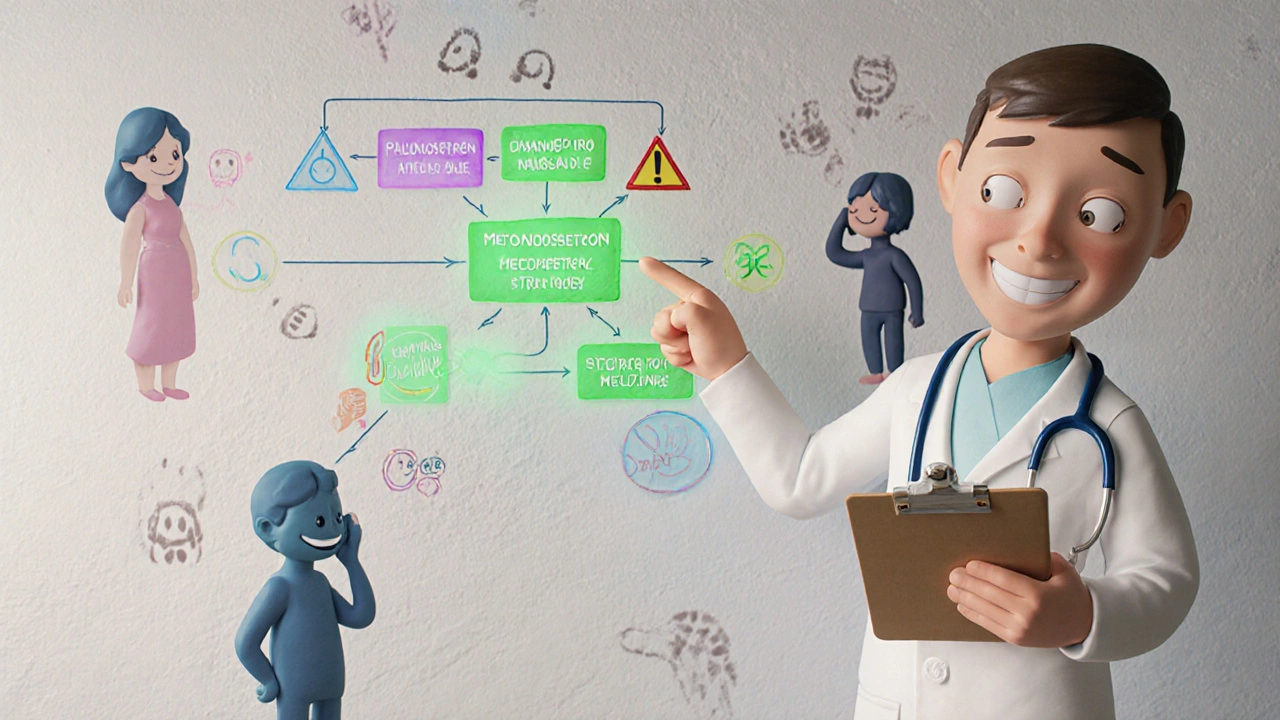Opioids and Antiemetics: Understanding Interaction Risks and Practical Management

Opioid-Induced Nausea Risk Estimator
This tool helps estimate the risk of opioid-induced nausea based on the specific opioid, patient characteristics, and dose. It uses evidence from clinical studies to provide personalized risk assessment and management recommendations.
When someone starts taking opioids for pain, nausea and vomiting often show up uninvited. About one in three patients experience these side effects, and for many, it’s worse than the pain itself. Studies show patients would rather endure more pain than deal with constant nausea. That’s not just discomfort-it’s a dealbreaker for sticking with treatment. The problem isn’t just the opioid. It’s what happens when you add antiemetics to fix it. Some help. Some make things worse. And a few can be dangerous.
Why Opioids Make You Sick
Opioids don’t just block pain signals. They also mess with your gut, your brainstem, and your inner ear. The main culprit is the mu-opioid receptor. When opioids bind to it in your digestive tract, they slow everything down. Food sits. Gas builds. That triggers nausea through nerve pathways connected to your brain’s vomiting center. At the same time, opioids stimulate the chemoreceptor trigger zone in your brain-a region packed with dopamine receptors. That’s why drugs like metoclopramide, which block dopamine, were once the go-to fix. But here’s the twist: opioids also increase sensitivity in your vestibular system. So if you feel dizzy when you stand up, it’s not just the painkiller. It’s your balance system being hijacked.The Antiemetic Maze: What Works and What Doesn’t
There are dozens of antiemetics out there, but not all are created equal when it comes to opioid-induced nausea. Let’s cut through the noise.- Ondansetron (Zofran) blocks serotonin in the gut and brain. It’s effective-studies show 8 mg and 16 mg doses reduce nausea in opioid-treated patients. But it carries a black box warning from the FDA for QT prolongation, which can trigger dangerous heart rhythms.
- Palonosetron (Aloxi), a newer serotonin blocker, outperformed ondansetron in one study: 42% of patients had nausea with palonosetron versus 62% with ondansetron. It lasts longer, too.
- Metoclopramide (Reglan) is a dopamine blocker and a prokinetic. Sounds perfect, right? Not quite. A 2022 Cochrane review of three trials found it did nothing to prevent vomiting or nausea when given before IV opioids. It didn’t even help reduce the need for rescue meds.
- Droperidol is another dopamine blocker with the same heart rhythm risks as ondansetron. It’s rarely used now outside of anesthesia settings.
- Scopolamine and meclizine work better if nausea comes with dizziness or motion sensitivity. They target the inner ear, not the gut or brainstem.
Prophylaxis? Maybe Not
For years, doctors gave antiemetics upfront-just in case. The idea was to prevent nausea before it started. But the evidence doesn’t back it up. The Cochrane review on metoclopramide was clear: no benefit. And that’s not an isolated finding. Most patients develop tolerance to opioid-induced nausea within 3 to 7 days. That’s a key point. You don’t need to treat something that fades on its own. So why do so many still prescribe antiemetics at the start? Habit. Fear of patient complaints. Lack of awareness. The CDC’s 2022 guideline says providers should warn patients about nausea before starting opioids-not automatically hand out meds. That’s the right shift: education over assumption.
When Antiemetics Are Necessary
There are times you can’t wait for tolerance to kick in. If a patient is vomiting, dehydrated, or can’t keep pain meds down, you need to act. But you need to pick the right tool.- If nausea is tied to dizziness or turning your head-use scopolamine or meclizine.
- If it’s constant, with no motion trigger-try ondansetron or palonosetron.
- If it’s severe and other drugs fail, low-dose haloperidol (an antipsychotic) can help. But monitor for sedation and movement issues.
The Hidden Dangers: Drug Interactions
This is where things get risky. Opioids don’t play well with other meds. Mixing them with antidepressants like SSRIs or SNRIs can trigger serotonin syndrome-a rare but life-threatening condition. Symptoms: high fever, rapid heart rate, confusion, muscle rigidity. The FDA requires this warning on all opioid labels now. Also, avoid combining opioids with other CNS depressants: benzodiazepines, sleep aids, alcohol. The result? Slowed breathing. Slowed heart rate. Death. Even common migraine meds like triptans can interact. A 2019 FDA safety update pushed manufacturers to update labeling for all opioid products to reflect these risks. Many providers still overlook this. Don’t be one of them.Best Practices: What to Do Instead
Forget blanket prescriptions. Here’s what actually works:- Start low, go slow. A 5 mg oral morphine dose twice daily is often enough for mild pain. Higher doses don’t always mean better pain control-they just mean more nausea.
- Rotate opioids. Not everyone reacts the same. Tapentadol causes 3-4 times less nausea per dose than oxycodone. Oxymorphone? It’s the worst offender. Switching opioids can cut nausea without losing pain relief.
- Monitor for tolerance. If nausea fades after a week, you can often stop the antiemetic. Don’t keep it going just because you started it.
- Teach patients. Tell them: ‘Nausea is common, but it usually goes away in a few days. If it’s bad, call us. Don’t take extra meds without checking first.’

What About Non-Drug Options?
Acupressure bands? Ginger? Aromatherapy? The data is mixed, but none are harmful. If a patient finds ginger tea helps, and it doesn’t interfere with their meds, why not? It’s low-risk, low-cost, and may improve quality of life. Just don’t treat it as a replacement for evidence-based care.Who’s at Highest Risk?
Not everyone gets nauseated. But some groups do-often badly.- Patients with a history of motion sickness
- Women (more sensitive to opioid-induced nausea)
- Older adults (slower metabolism, more comorbidities)
- Those on high-dose or long-acting opioids
- People with kidney or liver disease
Final Thought: Less Is Often More
The goal isn’t to eliminate every side effect. It’s to manage pain without making life worse. Most opioid-induced nausea resolves on its own. Most antiemetics aren’t needed upfront. And most interactions are preventable with a quick med review. The best antiemetic strategy? Don’t reach for a pill until you’ve asked: Is this really necessary? What’s the real cause? And what’s the risk of what I’m about to give?Do all opioids cause nausea equally?
No. Opioids vary widely in how likely they are to cause nausea. Oxymorphone has the highest risk per dose-about 60 times more than oxycodone. Tapentadol causes 3-4 times less nausea than oxycodone. Morphine and codeine are moderate. This matters when choosing or switching opioids. If nausea is a problem, switching to a different opioid may help more than adding an antiemetic.
Can I use ginger or acupressure instead of antiemetics?
Ginger and acupressure bands aren’t proven to replace prescription antiemetics, but they’re low-risk and may help some people feel better. Ginger has shown modest benefit in post-surgery nausea, and acupressure may reduce dizziness-related nausea. They’re worth trying if the patient prefers non-drug options, but don’t rely on them alone if vomiting is severe or dehydration is a risk.
How long does opioid-induced nausea last?
For most people, nausea improves within 3 to 7 days as the body adjusts to the opioid. That’s why prophylactic antiemetics often don’t work-they’re given for something that fades on its own. If nausea lasts longer than a week at a stable dose, look for other causes: infection, constipation, brain involvement, or another medication.
Is metoclopramide safe for opioid-induced nausea?
Not as a preventive. Studies show it doesn’t reduce nausea or vomiting when given before opioids. It can be used short-term if there’s clear evidence of slow stomach emptying, but even then, limit it to 5 days. Long-term use raises the risk of movement disorders like tardive dyskinesia. It’s not the first-line choice anymore.
Can antiemetics mask signs of something more serious?
Yes. If nausea continues beyond a week or gets worse after starting an opioid, it could signal something else: a brain tumor, infection, kidney failure, or drug interaction. Don’t just keep giving antiemetics. Reassess the whole picture. Is the patient on new meds? Have they had recent trauma? Are they dehydrated or constipated? Sometimes, treating the nausea hides the real problem.

Philip Rindom
November 17, 2025 AT 10:45Still, I get why docs overprescribe. Fear of complaints. Fear of being sued. Fear of looking like they don't care.
Scott Walker
November 18, 2025 AT 15:08Also, low-dose haloperidol? That's wild. I didn't even know that was a thing. Mind blown.
Sharon Campbell
November 20, 2025 AT 13:18sara styles
November 21, 2025 AT 07:31And don't get me started on palonosetron. That's a new drug with zero long-term safety data. They're testing it on you. Right now. In your living room. While you're scrolling Reddit.
They want you dependent. On everything. Pills. Doctors. Fear. Don't be fooled.
Jessica M
November 23, 2025 AT 05:43Additionally, the recommendation to rotate opioids based on individual receptor affinity profiles represents a sophisticated, patient-centered approach that is too often overlooked in primary care settings. I have incorporated these principles into my own practice and have seen a marked reduction in both nausea-related discontinuation and unnecessary polypharmacy.
Education over prescription remains the cornerstone. Thank you for this.
Jess Redfearn
November 23, 2025 AT 23:46Ashley B
November 24, 2025 AT 19:44And don’t even get me started on ginger. They banned it in 2017 because it interferes with the satellite network. They let you buy it online because they want you to think you’re free. You’re not. You’re being watched. Always.
Brendan Peterson
November 24, 2025 AT 22:27Also, the QT prolongation risk with ondansetron is real-but often overstated in non-cardiac populations. Still, we need better tools. Maybe we should be looking at NK1 antagonists more seriously.
Erika Lukacs
November 26, 2025 AT 09:44Yet, in prescribing antiemetics, are we not merely extending the logic of control? To treat nausea is to deny the body’s autonomy. Perhaps the most radical act is not to medicate at all-but to sit with the discomfort. To let it be. To listen.
Segun Kareem
November 26, 2025 AT 11:01My uncle took morphine after his surgery. Nausea hit hard. We gave him ginger tea, cold cloths, and sat with him. He didn’t take one antiemetic. By day 4, he was eating rice again.
Medicine doesn’t always mean a pill. Sometimes, it means showing up. And sometimes, it means trusting the body more than the pharmacy.
Rebekah Kryger
November 27, 2025 AT 22:17And don’t even get me started on 'tolerance.' Tolerance isn’t a feature-it’s a bug. It means your body’s rejecting the poison. But we just up the dose. That’s not medicine. That’s addiction engineering.